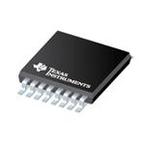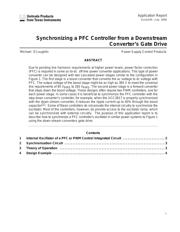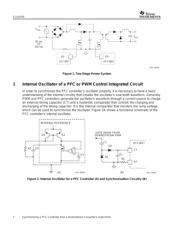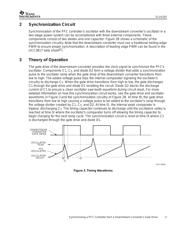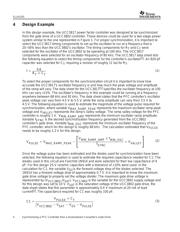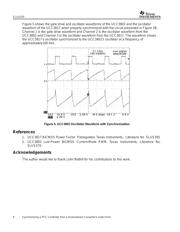下载

Application Report
SLUA245 - July 2000
1
Synchronizing a PFC Controller from a Downstream
Converter’s Gate Drive
Michael O’Loughlin Power Supply Control Produc
ts
ABSTRACT
Due to pending line harmonic requirements at higher power levels, power factor correction
(PFC) is required in some ac-to-dc off-line power converter applications. This type of power
converter can be designed with two cascaded power stages similar to the configuration in
Figure 1. The first stage is a boost converter that converts the ac voltage to dc voltage with
PFC. The output voltage of the boost stage might be as high as 385 V to meet the universal
line requirements of 85 V
RMS
to 265 V
RMS
. The second power stage is a forward converter
that steps down the boost voltage. These designs often require two PWM controllers, one for
each power stage. In some cases it is beneficial to synchronize the PFC controller with the
step down converter’s controller, for example, when the UCC3817 is properly synchronized
with the down stream converter, it reduces the ripple current up to 40% through the boost
capacitor
[1]
. Some of these controllers do not provide the internal circuitry to synchronize the
oscillator. Most of the controllers, however, do provide access to the oscillator ramp, which
can be synchronized with external circuitry. The purpose of this application report is to
describe how to synchronize a PFC controller’s oscillator in similar power systems to Figure 1
using the down stream converters gate drive.
Contents
1 Internal Oscillator of a PFC or PWM Control Integrated Circuit 2. . . . . . . . . . . . . . . . . . . . . . . . . .
2 Synchronization Circuit 3. . . . . . . . . . . . . . . . . . . . . . . . . . . . . . . . . . . . . . . . . . . . . . . . . . . . . . . . . . . . . .
3 Theory of Operation 3. . . . . . . . . . . . . . . . . . . . . . . . . . . . . . . . . . . . . . . . . . . . . . . . . . . . . . . . . . . . . . . . .
4 Design Example 4. . . . . . . . . . . . . . . . . . . . . . . . . . . . . . . . . . . . . . . . . . . . . . . . . . . . . . . . . . . . . . . . . . . . .

